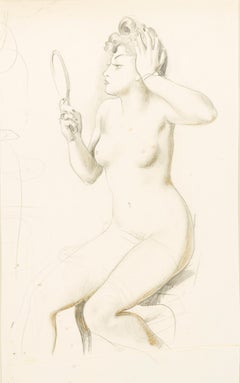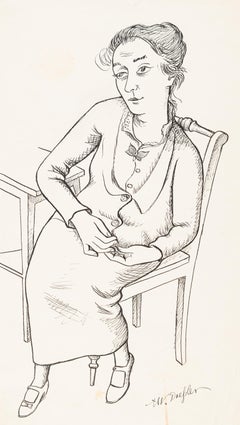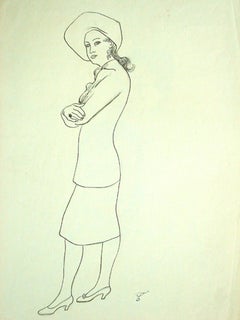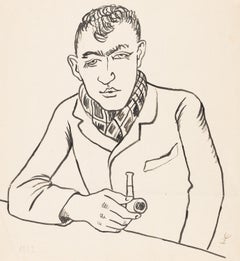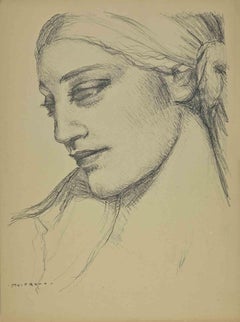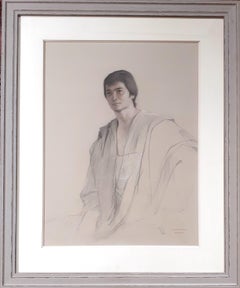August Wilhelm Dressler Portrait Drawings and Watercolors
German, 1886-1970
Wilhelm August Dressler is one of the painters of the New Objectivity (...) and was committed to social and political issues. The Berliner-of-choice defied stubbornly the summary classification. Dressler acted truthfully to his origin, temperament and insight as an individual who presents his bond as obligation, who takes his program as template and his slogan as abomination. Only few painters of his generation restrain so inconspicuously from the revolutionary storm and new trends that found its most effective expression in Expressionism of ” the Bridge” group and in the mystical works of the ‘Blue Rider’. Dressler’s self-imposed isolation is based neither on his capriciousness nor is it intentional – it is simply one of the inner necessities of his artistic existence.
One does not do justice to his work, if one tries to interpret only the visible facts, the artistic or the technical qualities in Dressler’s works. This painter lived his destiny with a stubbornly determined consequence of his fate: the pictures are nothing else than the graphic metaphors of the ‘introverted gaze’. He experienced grief and loneliness already during his youth. Dressler learns early about the shadow side of human existence – it becomes the basis of the way he perceived the world. ” I cannot separate myself from what has established me ” – there was a very immediate connection and solidarity between the painter and his personal experiences (l’art pour l’art attitude). Thus Dressler identifies himself with those embodiments of petty-bourgeois narrowness, with those disappointed and abandoned, with those who appreciate simple joys of life and those with quiet hopes. In his works the figurative language wins through its ability to depict and objectify feelings without words. Dressler does not paint to be modern or original. His way of perception is essential in a solid sense; he focuses on things, elements, and events that reflect a piece of life.
The closeness to the object and the attachment to the figure remain unchanged in Dressler’s oeuvre. One is tempted, looking at his works of five decades, to speak rather than about development but more of unfolding. The thematic inventory is from the beginning artist’s credo and basic motive: the form is added as the answer of the painter. It is Dressler’s personal preference not to correct reality nor to imitate it – his realism brings form and content, sensation and insight to life in a forceless manner.
Dressler feels, thinks and arguments his works on a more general level; his work is not an illustration of social misery or individual depravity. This “realist of the sharper tone” painterly transcends the limitations of genre and folklore; his “petty-bourgeois everyday life” is neither enclosed in the poor man’s pathos nor in the oh-human ecstasy. “Who controls the keyboard of nature”, proclaims Dressler, “can play in their own ways”.
Source: Delp’sche Verlagsbuchhandlung München, August Willhelm Dressler, Munich 1970.(Biography provided by Galerie Lehner)
to
6
6
3
3
Overall Height
to
Overall Width
to
6
6
6
6
3
3
2
2
2
1
6
1
1
16
184
72
50
47
4
4
2
2
2
Artist: August Wilhelm Dressler
Akt mit Strümpfen
By August Wilhelm Dressler
Located in Wien, 9
August Dressler is one of the painters of the New Objectivity. He is one of the lesser-known artists of the Weimar era, but he too, like his famous contemporaries Georg Grosz, John H...
Category
1920s Modern August Wilhelm Dressler Portrait Drawings and Watercolors
Materials
Watercolor, Ink
Akt mit Handspiegel
By August Wilhelm Dressler
Located in Wien, 9
August Dressler is one of the painters of the New Objectivity. He is one of the lesser-known artists of the Weimar era, but he too, like his famous contemporaries Georg Grosz, John H...
Category
20th Century Modern August Wilhelm Dressler Portrait Drawings and Watercolors
Materials
Pencil, Paper
Frau bei Tisch sitzend
By August Wilhelm Dressler
Located in Wien, 9
August Dressler is one of the painters of the New Objectivity. He is one of the lesser-known artists of the Weimar era, but he too, like his famous contemporaries Georg Grosz, John H...
Category
20th Century Modern August Wilhelm Dressler Portrait Drawings and Watercolors
Materials
Ink, Paper
Dame mit Hut
By August Wilhelm Dressler
Located in Wien, 9
August Dressler is one of the painters of the New Objectivity. He is one of the lesser-known artists of the Weimar era, but he too, like his famous contemporaries Georg Grosz, John H...
Category
20th Century Modern August Wilhelm Dressler Portrait Drawings and Watercolors
Materials
Pencil, Paper
Die Bildhauerin
By August Wilhelm Dressler
Located in Wien, 9
August Dressler is one of the painters of the New Objectivity. He is one of the lesser-known artists of the Weimar era, but he too, like his famous contemporaries Georg Grosz, John H...
Category
20th Century Modern August Wilhelm Dressler Portrait Drawings and Watercolors
Materials
Ink, Paper
Man with pipe
By August Wilhelm Dressler
Located in Wien, 9
August Dressler is one of the painters of the New Objectivity. He is one of the lesser-known artists of the Weimar era, but he too, like his famous contemporaries Georg Grosz, John H...
Category
1930s Modern August Wilhelm Dressler Portrait Drawings and Watercolors
Materials
Ink, Watercolor
Related Items
Portrait - Drawing by Alfred Moitroux - Mid-20th Century
Located in Roma, IT
Portrait is a drawing realized by Alfred Moitroux (1886-1938) in the Mid-20th Century.
Pencil ivory-colored paper
Good conditions with slight foxing.
The artwork is realized throu...
Category
Mid-20th Century Modern August Wilhelm Dressler Portrait Drawings and Watercolors
Materials
Paper, Pencil
H 11.42 in W 8.27 in D 0.04 in
Young man in a toga elegant man Latin American hyperrealist Hockney style
By Claudio Bravo
Located in Norwich, GB
Superb original drawing in coloured conté pencils, heightened with white on oatmeal coloured vergé paper by Claudio Bravo. The work was created during the artist's Moroccan period, a...
Category
1970s Modern August Wilhelm Dressler Portrait Drawings and Watercolors
Materials
Laid Paper, Conté, Color Pencil
H 30.32 in W 24.02 in D 0.4 in
African Mama - Vintage Illustration in Ink and Watercolor
By Irene Pattinson
Located in Soquel, CA
African Mama - Vintage Illustration in Ink and Watercolor
A charming illustration, by Irene Pattinson (American, 1909-1999), shows a woman with a...
Category
1950s American Modern August Wilhelm Dressler Portrait Drawings and Watercolors
Materials
Paper, India Ink, Watercolor, Pen
H 13 in W 10 in D 0.25 in
Portrait Drawing of a Man at a Desk in India Ink on Tan Paper
Located in Soquel, CA
Portrait Drawing of a Man at a Desk in India Ink on Tan Paper
Figurative drawing of a man at a desk by Jerry O'Day (American, 1912). The man is seated, about to pick up a pen. His features are somewhat exaggerated, showing foreshortening in the arms and legs. This piece is executed with confident strokes but nonetheless feels loose and playful.
Signed in the bottom right corner, "Jerry O'Day."
Mat size: 20"H x 16"W
Paper size: 12"H x 8"W
Image window size: 11.25"H x 7.25"W
Jerry O'Day is also known as Geraldine Heib. Born in Oakland, California, on June 17, 1912. Geraldine Heib assumed the name Jerry O'Day at an early age. She grew up in Washington and studied in Seattle at the Cornish School of Fine Arts. Upon moving to the San Francisco Bay area in 1938, she further studied with Bufano as a muralist for two years. O'Day wed sculptor David Lemon and had a gallery in a converted cod fishery in Belvedere from 1942 until 1963. At that time, the couple moved to a houseboat in Sausalito, where she remained until her demise on March 30, 1986.
Post War California artist, Jerry O'Day studied at the Cornish School of Fine Arts in Seattle; studied with Beniamino Bufano for two years. She lived in the artist's colony at the Cod fishery with artist David Lemon on Belvedere Island in the San Francisco Bay Area from 1942 - 1963.
Solo Exhibitions: City of Paris, Rotunda Gallery; Lucien Labaudt Gallery, 1963; Torrance Gallery, San Anselmo, 1955; Marin Art Gallery, Sausalito, 1956; Palace of The Legion of Honor, San Francisco, 1962; East & West Gallery, Fillmore Street, San Francisco; Landmarks Gallery, Marin County, 1991.
Selected Group Exhibitions: 65th Annual Painting and Sculpture Exhibition of the San Francisco Art Association at the San Francisco Museum of Art, 1945; Fourth Winter Invitational, California Palace of The Legion of Honor, San Francisco, 1963.
Source:
David J Carlson...
Category
Mid-20th Century American Modern August Wilhelm Dressler Portrait Drawings and Watercolors
Materials
India Ink, Paper
H 20 in W 16 in D 0.25 in
"March Avery in Beret, " Milton Avery, American Modernism, Portrait of Artist
By Milton Avery
Located in New York, NY
Milton Clark Avery (1885 - 1965)
March Avery in a Beret, 1951
Black crayon and graphite on cream wove paper
11 x 8 3/8 inches
Signed and dated lower left; ...
Category
1950s American Modern August Wilhelm Dressler Portrait Drawings and Watercolors
Materials
Graphite, Crayon, Paper, Pencil
"The Secretary" Minimalist Portrait in Ink on Paper by Geraldine Heib
Located in Soquel, CA
"The Secretary" Minimalist Illustrative Portrait in Ink on Paper
This charming portrait by Jerry O'Day (American, 1912), depicts a tight-lipped woman with stern eyebrows in a fun and simplistic style. Her lips pop in red and the fine line detail of her hair gives texture and movement to the piece. Her rounded figure is created using basic shapes cleverly placed, dressed in a turtleneck with dangling earrings. She is looking sideways, drawing the viewer's eyes in that direction.
Unsigned, but was acquired with a collection of the artist's work.
Presented in a new blue mat.
Mat size: 32"H x 26"W
Paper size: 28.5"H x 22.5"W
Image size: 15.5"H x 11.5"W
Jerry O'Day is also known as Geraldine Heib. Born in Oakland, California, on June 17, 1912. Geraldine Heib assumed the name Jerry O'Day at an early age. She grew up in Washington and studied in Seattle at the Cornish School of Fine Arts. Upon moving to the San Francisco Bay area in 1938, she further studied with Bufano as a muralist for two years. O'Day wed sculptor David Lemon and had a gallery in a converted cod fishery in Belvedere from 1942 until 1963. At that time, the couple moved to a houseboat in Sausalito, where she remained until her demise on March 30, 1986.
Post War California artist, Jerry O'Day studied at the Cornish School of Fine Arts in Seattle; studied with Beniamino Bufano for two years. She lived in the artist's colony at the Cod fishery with artist David Lemon on Belvedere Island in the San Francisco Bay Area from 1942 - 1963.
Solo Exhibitions: City of Paris, Rotunda Gallery; Lucien Labaudt Gallery, 1963; Torrance Gallery, San Anselmo, 1955; Marin Art Gallery, Sausalito, 1956; Palace of The Legion of Honor, San Francisco, 1962; East & West Gallery, Fillmore Street, San Francisco; Landmarks Gallery, Marin County, 1991.
Selected Group Exhibitions: 65th Annual Painting and Sculpture Exhibition of the San Francisco Art Association at the San Francisco Museum of Art, 1945; Fourth Winter Invitational, California Palace of The Legion of Honor, San Francisco, 1963.
Source:
David J Carlson...
Category
Mid-20th Century American Modern August Wilhelm Dressler Portrait Drawings and Watercolors
Materials
Ink, Paper
H 32 in W 26 in D 0.25 in
Indian Dancer - Vintage Illustration in Ink and Watercolor
By Irene Pattinson
Located in Soquel, CA
Indian Dancer - Vintage Illustration in Ink and Watercolor
A stoic, dark-haired woman in elaborate dress is sitting cross-legged in this illustration by Irene Pattinson (American, 1909-1999). Pattinson uses fine ink line detail and a vibrant pink watercolor for a splash of color.
Signed at the bottom, "Irene Pattinson."
Provenance: The Artist, Estate of Irene Pattinson: David Carlson; Estate of Larry Miller Fine Art, Robert Azensky Fine Art.
Presented in a new white mat with foam core backing.
Mat size: 16"H x 12"W
Paper size: 11.75"H x 8.5"W
Image size: 7.5"H x 6.5"W
Irene Pattinson (American, 1909-1999) studied at the California School of Fine Art (now The San Francisco Art Institute), San Francisco State College and The Marion Hartwell School of Design. She was President of the San Francisco Woman Artists Association 1955-56.
Provenance: The Artist, Estate of Irene Pattinson: David Carlson; Estate of Larry Miller Fine Art, Robert Azensky Fine Art.
Solo Exhibitions: Lucien Labaudt Gallery 1955; San Francisco Museum of Art, 1961 (39 works).
Selected Group Exhibitions: San Francisco Art Association Annual 1948, 54, 55; San Francisco Woman Artists, 1957-1960; Oakland Art Museum Annual, 1951, 58; California Palace of the Legion of Honor, 1960; Richmond Art Center, 1955, 56, 57, 58; San Francisco Art Institute 1959, 60. The Art Bank of the San Francisco Art Association, 1958, 59, 60, 62, 63; Winter Invitational, California Palace of The Legion of Honor, San Francisco, 1960; Fourth Winter Invitational, California Palace of The Legion of Honor, San Francisco, 1963.
Awards: First Place, San Francisco Woman Artists Assoc., 1957, 1959; San Francisco Art Festival 1957;Literature: San Francisco Art Institute - A catalog of the Art Ban 1962/63; San Francisco and the Second Wave: The Blair Collection
Exhibitions:
1963 The Art Bank of the San Francisco Art Association, San Francisco, CA
1963 California Palace of The Legion of Honor: Forth Winter Invitational, San Francisco, CA
1962 The Art Bank of the San Francisco Art Association, San Francisco, CA
1961 San Francisco Museum of Art, San Francisco, CA
1960 California...
Category
1950s American Modern August Wilhelm Dressler Portrait Drawings and Watercolors
Materials
India Ink, Paper, Watercolor, Pen
H 16 in W 12 in D 0.25 in
Lounge Chair Nap - Vintage Illustration in Ink and Watercolor
By Irene Pattinson
Located in Soquel, CA
Lounge Chair Nap - Vintage Illustration in Ink and Watercolor
A man lazes in a lounge chair, book still in hand, as he dozes off with a content e...
Category
1950s American Modern August Wilhelm Dressler Portrait Drawings and Watercolors
Materials
India Ink, Pen, Paper
H 12 in W 9 in D 0.25 in
Le Croates en Allemagne - Grenadier 1813 - Drawing By Herbert Knotel - 1940s
Located in Roma, IT
Le Croates en Allemagne is an original drawing in ink and watercolor realized by Herbert Knotel in 1930/40s.
Good condition except for being aged.
The artwork is depicted through s...
Category
1940s Modern August Wilhelm Dressler Portrait Drawings and Watercolors
Materials
Watercolor, Ink
H 10.24 in W 6.3 in D 0.08 in
" Woman & Bird" Acrylic And Ink Portrait Original Drawing On Paper by Devie
Located in Carmel, CA
Inspired by the theatre world, Devie had retained her own unique drawing strokes. Her works reflect an approachable other-worldliness. She paints a story to be told and answered.
Wi...
Category
21st Century and Contemporary Modern August Wilhelm Dressler Portrait Drawings and Watercolors
Materials
Acrylic, Ink, Handmade Paper
H 21 in W 17 in D 1 in
Large Drawing of Boy by French Armenian Modernist Jean Jansem Ecole De Paris Art
By Jean Jansem
Located in Surfside, FL
Jean Jansem (Hovhannes Semerdjian) 1920-2013
Young Boy (sad young man)
Hand signed lower left corner
Provenance: Marble Arch Gallery NYC
Measurements Image size: 25 by 18 inches, ove...
Category
1960s Modern August Wilhelm Dressler Portrait Drawings and Watercolors
Materials
Paper, Ink
Boston Abstract Expressionist Hyman Bloom Original Pencil Drawing Martin Sumers
By Hyman Bloom
Located in Surfside, FL
This is a unique artwork. This is an original Hyman Bloom drawing of fellow artist and his very good friend Martin Sumers.I believe this was drawn at the “variations of a theme” at Sumers gallery in NYC. The last two photos show a poster and a card from their shows. it is not included in this listing, it is just for provenance.
Provenance: Acquired from the Sumers estate collection.
Hyman Bloom (March 29, 1913 – August 26, 2009) was a Latvian-born American painter. His work was influenced by his Jewish heritage and Eastern religions as well as by artists including Altdorfer, Grünewald, Caravaggio, Rembrandt, Blake, Bresdin, James Ensor and Chaim Soutine. He first came to prominence when his work was included in the 1942 Museum of Modern Art exhibition "Americans 1942 -- 18 Artists from 9 States". MoMA purchased 2 paintings from the exhibition and Time magazine singled him out as a "striking discovery" in their exhibition review.
His work was selected for both the 1948 and 1950 Venice Biennale exhibitions and his 1954 retrospective traveled from Boston's Institute of Contemporary Art to the Albright Gallery and the de Young Museum before closing out at The Whitney Museum of American Art in 1955. In a 1954 interview with Yale art professor Bernard Chaet, Willem de Kooning indicated that he and Jackson Pollock both considered Bloom to be “America’s first abstract expressionist”, a label that Bloom would disavow. Starting in the mid 1950s his work began to shift more towards works on paper and he exclusively focused on drawing throughout the 1960s, returning to painting in 1971. He continued both drawing and painting until his death in 2009 at the age of 9
Hyman Bloom (né Melamed) was born into an orthodox Jewish family in the tiny Jewish village of Brunavišķi in what is now Latvia, then part of the Russian Empire
At a young age Bloom planned to become a rabbi, but his family could not find a suitable teacher. In the eighth grade he received a scholarship to a program for gifted high school students at the Museum of Fine Arts. He attended the Boston High School of Commerce, which was near the museum. He also took art classes at the West End Community Center, a settlement house. The classes were taught by Harold Zimmerman, a student at the School of the Museum of Fine Arts, who also taught the young Jack Levine at another settlement house in Roxbury. When Bloom was fifteen, he and Levine began studying with a well-known Harvard art professor, Denman Ross, who rented a studio for the purpose and paid the boys a weekly stipend to enable them to continue their studies rather than take jobs to support their families.
He took Bloom and Levine on a field trip to the Museum of Modern Art in New York, where Bloom was impressed by the work of Rouault and Soutine and began experimenting with their expressive painting styles.
In the 1930s Bloom worked sporadically for the Public Works of Art Project and the Federal Art Project (WPA), He shared a studio in the South End with Levine and another artist, Betty Chase. It was during this period that he developed a lifelong interest in Eastern philosophy and music, and in Theosophy.
He first received national attention in 1942 when thirteen of his paintings were included in the Museum of Modern Art (MoMA) exhibition Americans 1942: 18 Artists from 9 States, curated by Dorothy Miller. MoMA purchased two of his paintings from that exhibition, and he was featured in Time magazine. The titles of his paintings in the exhibition reflect some of his recurring themes. Two were titled The Synagogue, another, Jew with the Torah; Bloom was actually criticized by one reviewer for including "stereotypical" Jewish images. He also had two paintings titled The Christmas Tree, and another titled The Chandelier, both subjects he returned to repeatedly. Another, Skeleton (c. 1936), was followed by a series of cadaver paintings in the forties, and The Fish (c. 1936) was one of many paintings and drawings of fish he created over the course of his career.
Bloom was associated at first with the growing Abstract Expressionist movement. Willem de Kooning and Jackson Pollock, who first saw Bloom's work at the MoMA exhibition, considered Bloom "the first Abstract Expressionist artist in America." In 1950 he was chosen, along with the likes of de Kooning, Pollock, and Arshile Gorky, to represent the United States at the Venice Biennale. That same year Elaine de Kooning wrote about Bloom in ARTnews, noting that in paintings such as The Harpies, his work approached total abstraction: "the whole impact is carried in the boiling action of the pigment". In 1951 Thomas B. Hess reproduced Bloom's Archaeological Treasure in his first book, Abstract Painting: Background and American Phase, along with works by Picasso, Pollock, and others. Both de Kooning and Hess remarked on Bloom's expressive paint handling, a key characteristic of Abstract Expressionist painting.
As abstract expressionism dominated the American art world, Bloom became disenchanted with it, calling it "emotional catharsis, with no intellectual basis." In addition, instead of moving to New York to pursue his career, he opted to stay in Boston. As a result he fell out of favor with critics and never achieved the kind of fame that Pollock and others did. He disliked self-promotion and never placed much value on critical acclaim.
Many of Bloom's paintings feature rabbis, usually holding the Torah. According to Bloom, his intentions were more artistic than religious. He began questioning his Jewish faith early in life, and painted rabbis, he claimed, because that was what he knew. Over the course of his career he produced dozens of paintings of rabbis...
Category
20th Century Modern August Wilhelm Dressler Portrait Drawings and Watercolors
Materials
Paper, Pencil
August Wilhelm Dressler portrait drawings and watercolors for sale on 1stDibs.
Find a wide variety of authentic August Wilhelm Dressler portrait drawings and watercolors available for sale on 1stDibs. You can also browse by medium to find art by August Wilhelm Dressler in ink, paper, paint and more. Much of the original work by this artist or collective was created during the 20th century and is mostly associated with the modern style. Not every interior allows for large August Wilhelm Dressler portrait drawings and watercolors, so small editions measuring 11 inches across are available. Customers who are interested in this artist might also find the work of Sunil Das, Alfred Bendiner, and Raymond Debieve. August Wilhelm Dressler portrait drawings and watercolors prices can differ depending upon medium, time period and other attributes. On 1stDibs, the price for these items starts at $700 and tops out at $2,779, while the average work can sell for $1,695.

